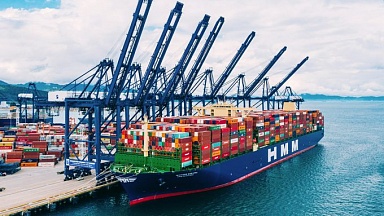Spot freight rates on the major East-West container trades edged up further this week as port congestion, box shortages and ongoing Asian exports through the Chinese New Year holidays kept supply chains at full tilt.
However, one shipping analyst now believes a downward rates correction is likely in the second quarter.
Drewry’s composite World Container index increased 1.1% to $5,249.80 per 40ft container yesterday.
The Shanghai—Los Angeles trade continues to be impacted by lengthy delays for vessels calling at LA/Long Beach terminals and spot freight rates on the lane nudged up by 3% or $112 this week to reach $4,348 per FEU.
On the headhaul Shanghai—Rotterdam trade spot rates also increased — up 2% or $145 this week to average $8,608 per FEU, according to Drewry.
Despite the weekly rises, analysts at Maritime Strategies International (MSI) believe there are indications that spot freight rates will start to ease in the coming months.
«We anticipate a correction in freight rates in Q2, although the timing here remains uncertain, and this does not portend immediate relief from the chaos in the market — cargo backlogs and port congestion promise further months of schedule delays and costly surcharges for shippers,» said the analyst’s latest container report.
MSI’s Time Charter Rate Index has now reached its highest level since 2007 as demand for vessels continues to outstrip supply. The upshot is that only around 1% of the global fleet is currently idle and many of these vessels are undergoing repairs.
«With carrier booking volumes reportedly still strong, several months of further port congestion to contend with, and uncertainty over the scale of pent-up demand post Lunar New Year, nothing is yet set in stone and strong freight and time charter markets by historical standards are expected to endure at least into H2 21,» not MSI.
’Colossal’ volume
According to the analyst, US demand for goods from the Far East continues to be the root cause of wider market dislocations and shortages of equipment and vessels. «Asia-US volumes reached over 5 Mn TEU in Q4 20, the highest level on record,» it said.
«This colossal volume of goods has been imported into ports that are generally less productive than major European or Chinese counterparts, and over distances that favour the use of midsize vessels for which there is a liquid time charter market.»
While a comparable surge on the Asia-Europe trade would have led to similar outcomes in terms of equipment shortages and mid-size vessel demand, MSI concluded that «the US that has led the wider market, and the pace at which trans-Pacific volumes cool and port congestion is reduced will do most to determine the timing of a market correction».
It added: «Looking ahead, we expect the US demand surge to continue into Q2 21 due to back-orders accumulated over Lunar New Year, as well as a fresh round of US stimulus payments. Since port executives at the key US terminals expect ongoing congestion some way into Q2 21, we believe the trans-Pacific market will absorb an abnormal volume of tonnage for the next 3- 4 months at least.»




